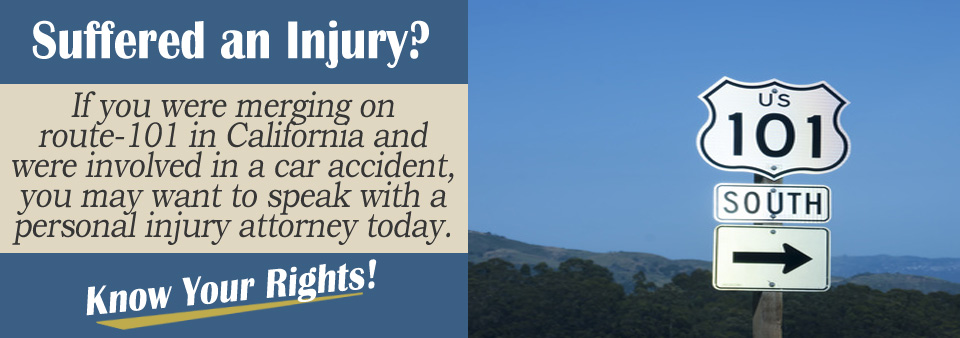If you use a particular stretch of highway regularly you become familiar with on and off ramps as well as the lane configuration. However, many other drivers may be less familiar with how to merge safely than you. You can be hit when merging or when someone else is merging and fails to adjust their driving to suit the conditions.
Merging accidents can result in serious injuries because of the speed that vehicles travel at on major highways like Route 101. If you are injured in a merging accident and believe that the driver who hit you was at fault, you may be able to claim compensation by filing a personal injury claim with the help of an attorney.
U.S. Route 101 in California
Route 101 is one of the oldest north south highways linking the states of Washington, Oregon and California. It is 1,550 miles long between the Northern Washington community of Tumwater and the L.A. Eastern Interchange in California. This interchange is reputed to be one of the world’s busiest highway interchanges.
Despite the busier part of Route 101 in Southern California, it has been largely replaced in importance by I-5, which runs parallel, but further inland. I-5 is busier and faster and connects more cities along a geographically easier route than Route 101. In fact, the “101” as it is more affectionately known as is as much a tourist route through northern California and the Oregon coast.
One section of highway in northern California is also known as the “Redwood Highway” as it passes through some of the last stands of these impressive trees. Accidents on Route 101 may not have the same frequency level per mile as I-5, but they still happen, especially during the busier summer touring months.

What to Do If Hit While Merging On Route 101
It is important to establish fault in any vehicle accident, whether it is a merging accident or not. Each of the 3 states through which Route 101 passes has slightly different negligence rules, which can impact on your ability to obtain compensation.
In California, for example, a pure comparative negligence rule allows you to obtain compensation as a percentage of the fault determined. For example, if you were 30% to blame for your own injuries and have claimed a total of $20,000, you may be allocated 100 – 30 = 70% of this amount, i.e. $14,000. Oregon and Washington accidents may be treated differently.
You will also be made aware by your attorney about time limits for filing a claim. A personal injury claim against a private individual must be made within 2 years of the injury in California, but 6 months is the limit if a government employee hit you.
Evidence to Gather If Hit While Merging On Route 101
It is not possible to obtain compensation after a merging accident unless you can demonstrate who was at fault and how much it has set you back financially. Insurance adjusters and courts (if it comes to a trial) are expecting to see a clear link between your injuries and someone else’s negligence.
Typical documents that will be expected are the police report compiled after the crash, medical reports and invoices from doctors, hospitals, the repair yard that has been used to repair your vehicle, etc. In some incidences, you may be able to make it easier for you to establish fault later on if you can obtain photographic evidence at the crash scene or at least names and contact details of people who were prepared to provide witness statements.
Hire an Attorney
It is usually better to discuss your claim with an attorney before actually filing it. This can save you time and ensure you submit important documentation with your claim. Personal injury attorneys familiar with merging accidents will understand how to negotiate with insurance adjusters who may otherwise dismiss your claim or put up resistance to it.